

Algorithom to find overlaping subnets (Internet IPv4) Unique values in an array in Perl. In this part of the Perl tutorial we are going to see how to make sure we only have distinct values in an array.
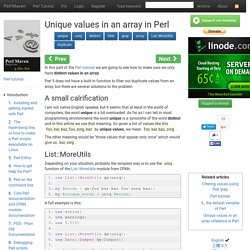
Perl 5 does not have a built in function to filter out duplicate values from an array, but there are several solutions to the problem. A small calrification I am not native English speaker, but it seems that at least in the world of computers, the word unique is a bit overloaded. As far as I can tell in most programming environments the word unique is a synonime of the word distinct and in this article we use that meaning. So given a list of values like this foo, bar, baz, foo, zorg, baz by unique values, we mean foo, bar, baz, zorg. The other meaning would be "those values that appear only once" which would give us bar, zorg. List::MoreUtils Depending on your situation, probably the simplest way is to use the uniq function of the List::MoreUtils module from CPAN.
How to assign an array to a value in hash? Perl Regular Expressions. Troubleshooters.Com and Code Corner Present Copyright (C) 1998-2001 by Steve Litt Without regular expressions, Perl would be a fast development environment.
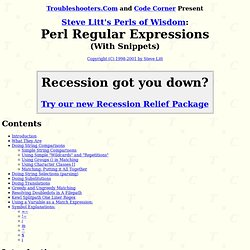
Probably a little faster than VB for console apps. With the addition of regular expressions, Perl exceeds other RAD environments five to twenty-fold in the hands of an experienced practitioner, on console apps whose problem domains include parsing (and that's a heck of a lot of them). Regular expressions is a HUGE area of knowledge, bordering on an art.
Calculate netmask in Perl. Converting IP addresses to hex, decimal and binary with Perl. IP Calculator / IP Subnetting. Networking - subneting in cidr notation. How do I get the full path to a Perl script that is executing. Perl - Can I get paths related to where a script resides and where it was executed from. Perl - Can I get paths related to where a script resides and where it was executed from. Initializing global variable on Perl module (with BEGIN block) include. Perl - Which script initialized module. How do I include a Perl module that's in a different directory. Extending the library path. By default perl looks for modules in the standard library path and the current directory.
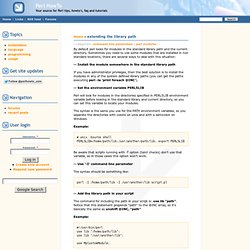
Sometimes you need to use some modules that are installed in non standard locations; there are several ways to deal with this situation: -- Install the module somewhere in the standard library path If you have administrator privileges, then the best solution is to install the modules in any of the system defined library paths (you can get the paths executing perl -le 'print foreach @INC'). -- Set the environment variable PERL5LIB Perl will look for modules in the directories specified in PERL5LIB environment variable before looking in the standard library and current directory, so you can set this variable to locate your modules. The syntax is the same you use for the PATH environment variables, so you separate the directories with colons on unix and with a semicolon on Windows. Example: # unix, bourne shell PERL5LIB=/home/path/lib:/usr/another/path/lib; export PERL5LIB -- Use '-I' command line parameter. Calling perl subroutine from shell.
Perl Join with array reference. Why doesn't my regular expression work with Perl's Switch module. Perl Hash Howto. This how-to comes with no guaratees other than the fact that these code segments were copy/pasted from code that I wrote and ran successfully.
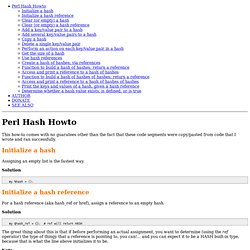
Initialize a hash Assigning an empty list is the fastest way. Solution my %hash = (); Initialize a hash reference For a hash reference (aka hash_ref or href), assign a reference to an empty hash. my $hash_ref = {}; # ref will return HASH The great thing about this is that if before performing an actual assignment, you want to determine (using the ref operator) the type of thingy that a reference is pointing to, you can!... Note. Python - Is there a builtin "hash to string" in Perl.
Python - Is there a builtin "hash to string" in Perl. Given/when – the Perl switch statement. PCA): Can't use string ("0") as an ARRAY ref while "strict refs" Función split y join - Perl En Español. Introducción Después de hacer varios tutoriales para programadores de perl con experiencia, decidí hacer algunos sumamente básicos, para todos ustedes que esten en sus primeros pasos con perl.
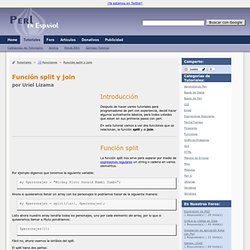
En este tutorial vamos a ver dos funciones que se relacionan, la función split y el join. Función split La función split nos sirve para separar por medio de expresiones regulares un string o cadena en varios elementos. Por ejemplo digamos que tenemos la siguiente variable: my $personajes = "Mickey Pluto Donald Bambi Dumbo"; Ahora si quisieramos llenar un array con los personajes lo podríamos hacer de la siguiente manera: my @personajes = split(/\s+/, $personajes); Listo ahora nuestro array tendría todos los personajes, uno por cada elemento del array, por lo que si quisieramos llamar a Pluto pondríamos: $personajes[1]; Fácil no, ahora veamos la sintáxis del split.
El split tiene dos partes: split([expresion|cadena], [variable]); my $informacion = "Uriel,Lizama,19"; Perl Array: Quick Guide to Arrays In Perl. Declaring Perl ArraysJoining Arrays with join()Creating arrays with split()Dumping (Viewing) Perl ArraysAccessing Array ElementsPerl Push: Adding Items to Arrays With Push and UnshiftPerl Pop: Removing Items from Arrays with Pop and ShiftThe Size of an ArrayPerl Foreach: Iterating Over ArraysArrays of ArraysAdd an Element to an Array of ArraysMap and Grep: Two Useful Array FunctionsSorting Arrays Declaring Perl Arrays You can declare an array in Perl like this: my @items; You can initialize and declare the array at the same time like this; # Declare an array and initialize with three strings. my @items = ('apple', 'banana', 'orange');
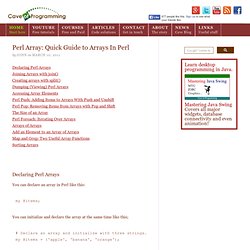
Regex - Variable inside grep in Perl. Global symbol requires explicit package name. Global symbol requires explicit package name is a common, and IMHO very misleading error message of Perl.
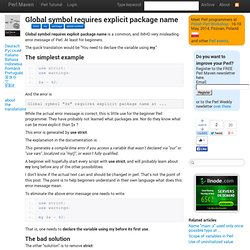
At least for beginners. The quick translation would be "You need to declare the variable using my. " The simplest example use strict;use warnings;$x = 42; And the error is Global symbol "$x" requires explicit package name at ... While the actual error message is correct, this is little use for the beginner Perl programmer. This error is generated by use strict. The explanation in the documentation is: This generates a compile-time error if you access a variable that wasn't declared via "our" or "use vars", localized via "my()", or wasn't fully qualified.
A beginner will hopefully start every script with use strict, and will probably learn about my long before any of the other possibilities. I don't know if the actual text can and should be changed in perl. To eliminate the above error message one needs to write: Preface (Modern Perl 2011-2012) Modern Perl is one way to describe the way the world's most effective Perl 5 programmers work.
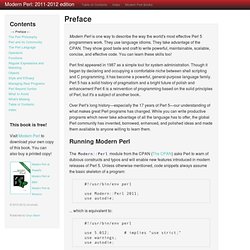
They use language idioms. They take advantage of the CPAN. They show good taste and craft to write powerful, maintainable, scalable, concise, and effective code. You can learn these skills too! Builtin - What does shift() do in Perl. Is it possible to do pass by reference in Perl? Installing Net/SSH/Perl.pm.